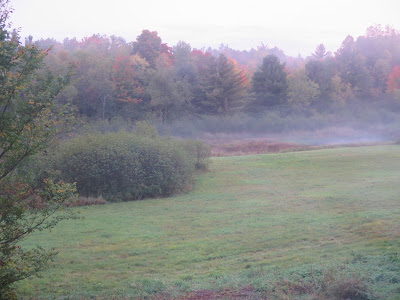this is well underway now,
filled with one signature of eight pages
pages that have fold-outs and add-ons and prints and stitches and words...
i'm not done, but the structure is there
and the lilies and birds are, too.
it's a record of this summer of deep peace
of joy in change.
and a wee bit of fear, as in respect, too.
mostly, though, it's a journal of content.
the changes here
are brilliant
and at the new place called home
view from the little big room.
the pond is a stream now,
almost all dried up.
in yesterday's mail,
a
sweet tiny dress card from aimee
yesterday i went out
in the rain,
in boots and hat
gathering printing plants.
i came in and made three large pieces
all finished up and in the press.
just in case of ticks
i showered and shampooed and did the thorough check.
remember the hat?
well, my hair is sometimes more out of control than i know...
and this was what remained:
a coil of long curls
a leaf and
a worm.
geesh!







geesh!
ReplyDeletejean!!!!!
ReplyDeletewonderful visions around your place
ReplyDeletesuch gentle beauty & deep love pour out of this post
ReplyDeleteReturned with this from 'The Writers Almanac today...because of the worm in that last picture I thought you'd find it interesting:
ReplyDeleteCharles Darwin published "The Formation of Vegetable Mould Through the Action of Worms" on this date in 1881. It was his last scientific book, and his most successful. In it, he explains that the very ground we walk upon has passed through the bodies of worms and emerged as castings. He also estimated that there are more than 53,000 worms at work in any given acre of land, and reported that they had turned a rocky field behind his uncle's house into smooth soil over the course of many years. He was fascinated by the work of the earthworm, which he called an "unsung creature which, in its untold millions, transformed the land as the coral polyps did the tropical sea." On the surface, the study of earthworms seems to have little to do with the work on evolution and natural selection that made him famous. But this book, too, was about the inexorable processes of nature that, over long spans of time, can bring about dramatic changes.
The book started as a paper, which Darwin presented before the Geological Society of London in 1837. In 1842, Darwin spread a layer of chalk fragments over a pasture near his house and observed the worms' effect on it for almost 30 years. He placed a large, flat stone - which he dubbed the worm stone-in a field and measured the movement of soil as the worms digested the earth beneath the stone. He also kept worms inside the house, examining the effects of bright light and sound. He figured out through trial and error what the worms' favorite food was: carrots. He was fond of the worms, which were unmoved by art or music - much as Darwin himself remained unmoved by the arts.
By 1881, Darwin's health was failing, and he remarked to a friend that he wanted to complete his book on worms before he joined them in the local cemetery. He pushed his publisher to bring the book to press as soon as possible. When it was first published, the work of 44 years, Worms was a best-seller, and Darwin received a surprising amount of fan mail. He died six months after the book was published.
michelle, thank you for this lovely tale. i feel very happy to be in such company! worms, leaves and darwin, and of course you for figuring it all out!
ReplyDeletemo, loving this earth, well, it's imperative, don't you think? if we're to have any future, we damn well better be loving this place.
Learning about mist firsthand.
ReplyDelete